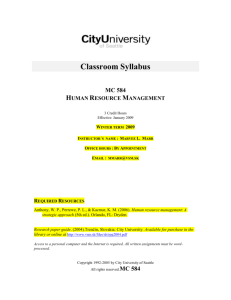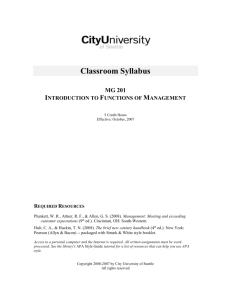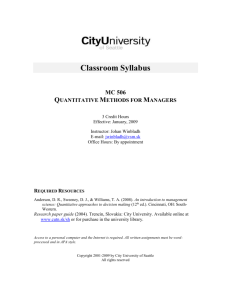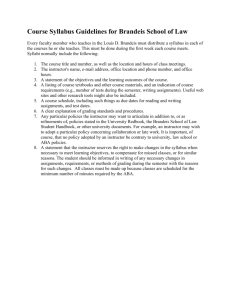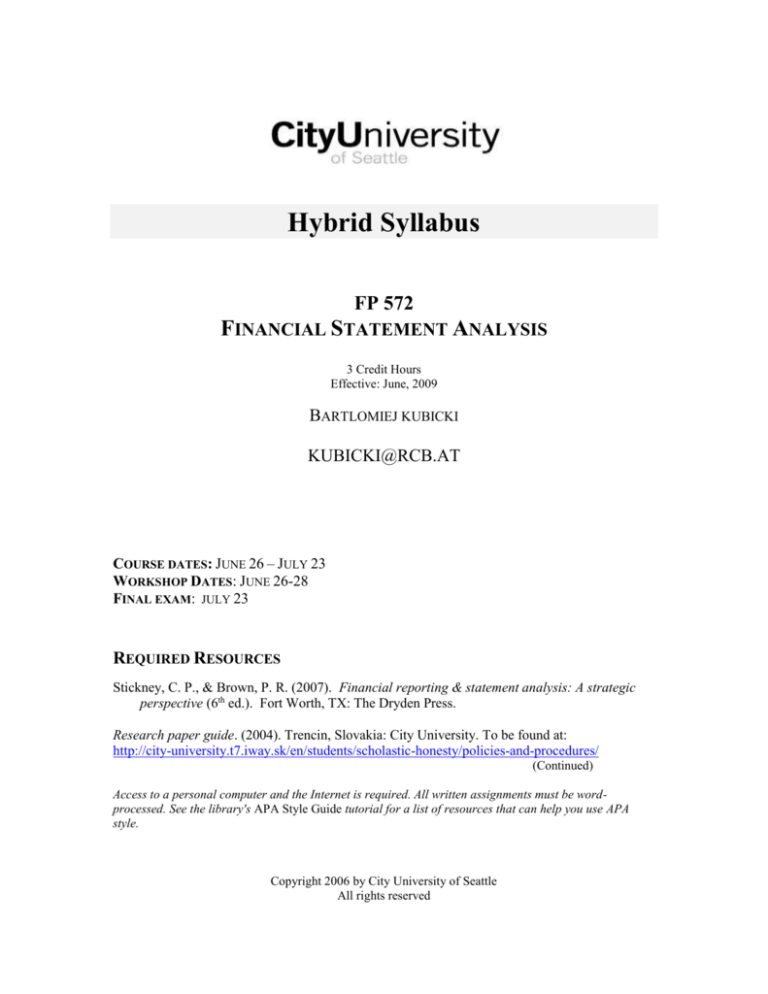
Hybrid Syllabus
FP 572
FINANCIAL STATEMENT ANALYSIS
3 Credit Hours
Effective: June, 2009
BARTLOMIEJ KUBICKI
KUBICKI@RCB.AT
COURSE DATES: JUNE 26 – JULY 23
WORKSHOP DATES: JUNE 26-28
FINAL EXAM: JULY 23
REQUIRED RESOURCES
Stickney, C. P., & Brown, P. R. (2007). Financial reporting & statement analysis: A strategic
perspective (6th ed.). Fort Worth, TX: The Dryden Press.
Research paper guide. (2004). Trencin, Slovakia: City University. To be found at:
http://city-university.t7.iway.sk/en/students/scholastic-honesty/policies-and-procedures/
(Continued)
Access to a personal computer and the Internet is required. All written assignments must be wordprocessed. See the library's APA Style Guide tutorial for a list of resources that can help you use APA
style.
Copyright 2006 by City University of Seattle
All rights reserved
REQUIRED RESOURCES (continued)
Financial Calculators
Students should note that in order to meet the course requirements they will need to have, and be
able to use, a financial calculator. Two recommended models are the Hewlett Packard 10B and
the Texas Instruments BAII Plus. An alternative is acceptable, as long as it is a financial (not
scientific) calculator with the Internal Rate of Return (IRR) function. Students should acquire a
suitable calculator and use the instruction manual, if necessary, to learn how to make the basic
settings and to solve the types of time value of money problems covered in the relevant textbook
chapter. Two important settings are the number of annual payments (1/12) and for payments
occurring at the beginning or end of a period. This preparation should be done before the first
scheduled session or week devoted to the time value of money. Course instructors are not
responsible to give tutorials on calculator use.
FP 572
SYL
Page 2
Eff: 10/06
FP 572
FINANCIAL STATEMENT ANALYSIS
This document provides an overview of the course foundation elements, assignments, schedules,
and activities. For information about general City University of Seattle policies, please see the
City University of Seattle catalog. If you have additional questions about the course, please
contact your instructor.
Notification to Students with Disabilities
If you are a student with a disability and you require certain help, please contact the site
administrator as soon as possible.
Scholastic Honesty
City University of Seattle expects each student to do his/her own work. The University
has "zero tolerance" for cheating, plagiarism, unauthorized collaboration on assignments
and papers, using "notes" during exams, submitting someone else's work as one's own,
submitting work previously submitted for another course, or facilitating acts of academic
dishonesty by others. The penalties are severe! A first offense can result in a zero grade
for the course and suspension for one quarter; a second offense can result in a zero grade
for the course and suspension for two or more quarters; a third offense can result in
expulsion from the University. The Policy and Procedures may be found at
http://www.vsm.sk/en/students/scholastic-honesty/policies-and-procedures/.
In addition to providing your work to the instructor for grading, you must also submit an
electronic copy for the CU archives (unless the work is specifically exempted by the
instructor). You will not receive a grade for particular work until and unless you submit
this electronic copy. The procedure for submitting work to the archives is to upload it via
the website http://www.vsm.sk/en/students/on-line-center/uploader/uploader.html. Files
should include the cover page of the work with the student name, instructor name, course
name and number, and date. File names should indicate the type of assignment, such as
“researchpaper.doc”, “casestudy.doc” or “ thesis.doc” (student name should not be a part
of the file name because the system adds it). All files received into the archives are
submitted to www.TurnItIn.com for plagiarism checking.
COURSE DESCRIPTION
An introduction to financial statement analysis and its use in developing estimates, inferences,
and forecasts regarding a company’s economic performance, prospects, and risks. Students will
get insights into the sources and nature of the data that appear in financial statements. They will
then learn and apply methods of financial statement analysis used by different types of decisionmakers, including security analysts, investment advisors, fund managers, bankers, and individual
investors.
FP 572
SYL
Page 3
Eff: 10/06
LEARNING GOALS
Upon the successful completion of this course, you will be able to:
1. Distinguish a company’s operating, financing, and investing activities by researching its
published financial reports, including its audited balance sheets, income statements, cash flow
statements, and statements of shareholders’ equity;
2. Investigate the economic, legal, and competitive environment of a firm by researching its
history and that of its peers and industry using reports in the financial media;
3. Analyze a company’s business strategy and competitive position using information obtained
from its financial reports and from industry sources;
4. Judge the degree to which a company’s accounting policies, practices, and estimating
methods yield clear and accurate pictures of the true state of the company and its financial
performance;
5. Forecast a company’s short-term and long-term financial strengths and weaknesses, based on
an analysis of its financial reports and comparisons with financial reports of its competitors;
6. Evaluate a company’s profitability, and risks and return on invested capital using financial
statement analysis and industry and market trends;
7. Assess the strengths and weaknesses of financial statement analysis as a method of evaluating
a company’s performance, prospects, and risks.
CORE CONCEPTS
To achieve the goals of this course, you will need to master the following core concepts:
1. Objectives and challenges of financial accounting and financial reporting;
2. Goals and types of business analysis, including fundamental analysis and technical analysis;
3. Generally Accepted Accounting Principles (GAAP);
4. Accounting bias, including aggressive accounting and off-balance-sheet financing;
5. Accrual vs. cash accounting;
6. Professional, legal, and ethical standards applicable to financial reporting;
7. The rules of disclosure laid down by the SEC and other regulators of financial reporting;
8. Financial analysis, including trend analysis and ratio analysis;
9. Basic business activities: planning, financing, investing, and operating;
10. Cash flow analysis and forecasting;
11. Risk analysis, including sensitivity analysis;
12. Profitability analysis, including return on assets and return on equity;
13. Prospective analysis and proforma financial statements;
14. Credit analysis and bankruptcy prediction;
15. Equity analysis and valuation methods, including book value and market value;
16. Analysis of mergers, acquisitions, leveraged buyouts, and spin-offs.
FP 572
SYL
Page 4
Eff: 10/06
ENTRY COMPETENCIES
A prerequisite for enrolling in this course is completion of MC 500 (Managerial Accounting), or
evidence of an equivalent knowledge of accounting.
RECOMMENDED SUPPLEMENTARY RESOURCES
As a City University of Seattle student, you have access to library resources regardless of where
and how you are taking this class. To access the resources that are necessary to complete your
coursework and assignments, visit the library menu in the My.CityU portal at http://my.cityu.edu.
A good place to begin your research is through the program or course resource sections
that provide links to relevant journals, books, and Web sites. Search the library's online catalog
to locate books and videos, and place requests to have items mailed to you (services vary by
location). Search the online databases for journal, magazine, and newspaper articles. Articles that
are not available full text in the library's collection can be requested from other libraries and
delivered to you electronically.
For additional help, submit your question via the Ask a Librarian e-mail service available through
the portal or call 800.526.4269 (U.S. or Canada) or 425.709.3444.
PRINT RESOURCES
The following are professional journals that feature appropriate scholarly articles that may be
useful in this course:
Financial Analysts Journal
Financial Executive
Financial Management
Financial Planning
Harvard Business Review
Journal of Finance
Journal of Financial Planning
Journal of Portfolio Management
ELECTRONIC RESOURCES
The following Internet resources may be of use to you in this course. Please be aware that Web
addresses may change from time to time. Consult your instructor if you have questions about
electronic resources.
AICPA (American Institute of Certified Public Accountants)
http://www.aicpa.org
City University of Seattle
http://www.cityu.edu
FASB (Financial Accounting Standards Board)
http://www.fasb.org
IRIN: Company Links & Annual Reports
http://www.irin.com
FP 572
SYL
Page 5
Eff: 10/06
Journal of Finance Online
http://www.afajof.org/jofihome.shtml
Public Register’s Annual Report Service
http://www.prars.com
SEC (Securities Exchange Commission): EDGAR online database
http://www.sec.gov
Textbook site
http://www.swlearning.com/accounting/stickney/statement_analysis_5e/stickney.
html
The Accounting Review: Quarterly Journal of the American Accounting Association
http://accounting.rutgers.edu/raw/aaa/pubs/acctrev.htm
Wall Street Journal Online
http://www.wsj.com
FP 572
SYL
Page 6
Eff: 10/06
OVERVIEW OF COURSE ACTIVITIES AND GRADING
You will receive a grade for the course using City University of Seattle’s decimal grading system,
based on the following:
Assignments
Online Discussions
Group Case Study Analysis
Individual Financial Statements Analysis
Final Examination
15%
30%
30%
25%
TOTAL
100%
Please see the current City University of Seattle catalog or consult your instructor for guidance in
determining your decimal grade.
EXPLANATION OF ASSIGNMENTS AND GRADING
ONLINE DISCUSSION
A discussion question or other task from your instructor appears weekly in the discussion forum.
Sometimes these will be questions to discuss based on the readings, sometimes you may be asked
to post real-life examples that relate to the course, or sometimes you may post your written work
and be required to give feedback on your classmates’ work. You are to post your answer as well
as responses to two other students’ answers to the discussion forum by the end of each session.
Each topic will open on Monday, 9am of each week and be open till Friday, 3pm of each week. You must
post your first response to the questions by Tuesday, 4pm. Then, read what others have written and add at
least two more postings responding to others’ ideas. That means you should have at least 3 postings per
topic. Please note that you cannot make all your posts on the same day; post in one topic on at least three
different days.
The forum is to help promote student-to-student discussion. Your instructor will not be responding to
individual posts, but may enter the discussions with comments, corrections, and additional questions, and
will close each topic. If you have a question or comment that is specifically for your instructor, email your
instructor directly or use the Question and Answer forum.
After the topic is closed, your participation will be evaluated. Although the tone of your discussion board
postings can be informal, your instructor will expect them to be on a professional level. You will be
evaluated on participating regularly, being aware of the issues from the reading, expressing your own ideas
clearly, supporting your ideas, maintaining a respectful and inoffensive tone, thoughtfully reacting to
others' ideas, and using clear and appropriate English.
Grading Criteria for Online Discussion
Quality of responses (thoughtful, supported, clear)
Quantity of responses (3 relevant responses per topic)
TOTAL
50%
50%
100%
FP 572
SYL
Page 7
Eff: 10/06
GROUP CASE ANALYSIS
Your instructor will assign the two graded case analyses, selected from the cases provided at the
end of the chapters of the textbook.
Refer to each question in the case and answer it as fully and completely as you can. Clearly label
which part of the question you are answering and be sure to show all computations, where
applicable, to support your conclusions. State all assumptions and defend them clearly. Your
instructor may give you some guidance regarding your assumptions. Present your case analysis
in a neat and professional format that is organized, logical, and easy to follow. All narrative
answers should be double-spaced, and as in-depth as possible. Refer to the section in this syllabus
on “Professional Presentation” for appropriate format.
The case study analysis will be prepared in group of 2- 3 students and is to be provided to the
instructor by 4pm CET on the 3rd of August.
Each of the group is to prepare the full analysis of the chosen by them company. The analysis
should be based on at leat last 5-year financial statements.
The analysis should contain:
- description of the company
- macro analysis
- analysis and evaluation of the industry and it’s life cycle
- analysis and evaluation of the strategy of the company
- financial statements analysis (horizontal and vertical analysis of the assets, liabilities,
income statement and cash flow, ratio analysis (profitability and risk, working capital,
margins etc.), du Pont analysis of ROE). The ratios should be compared to industry
norms. Emphasis the most important changes over time and what and why has impacted
those changes. Please do not describe each ratio separately, just make general remarks
regarding given topic, for example short-term liquidity risk (how it has changed over
time, positive/negative, what has had the most signigicant impact on the change), and in a
table provide all the ratios for the years under analysis
- forecast the financial statements for the next 3 years. Clearly and reasonably state your
assumptions.
- value the company with at least two valuation methods provided during the course
- make recommendation regarding the company
All the calculations along with the financial statements should be provided in an excel
spreadsheet (and presented in a professional fashion). Please leave all the formulas, so that I can
check the origination of the numbers. In the paper, provide with tables showing the results of the
calculations (no need to show the financial statements). Charts are welcome.
INDIVIDUAL CASE STUDY – FINANCIAL STATEMENTS ANALYSIS
You will be provided with financial statements of a company. Based on this you are to write an
analysis of those statements as presented during the course. Information regarding the company
you can find in the internet. The following is expected in the analysis:
- description of the company
- horizontal and vertical analysis of its financial statements
- ratio analysis: profitability and risk, working capital, margins, du Pont analysis etc
In this case no spreadsheet is required so that please input all the numbers (results of your
calculations) into the professionally presented tables. Please, do not describe each ratio
FP 572
SYL
Page 8
Eff: 10/06
separately, simply provide me with the most important conclusions regarding each sub-topic (eg,
short-term liquidity analysis) and particularly, state what has had the most significant (and why)
influence on changes in the ratios/margins/costs etc
The assignments are to be provided in writing to the instructor by July 13th, 4pm
PROFESSIONAL PRESENTATION OF WRITTEN WORK
All assignments submitted for this course should be of professional quality. You should present
each paper in a format that would be appropriate for submitting to upper management.
This course requires that you use the American Psychological Association (APA) style in
preparing any written work where other sources are used. A recommended style guide is
included in the “Required Text and Materials” section. Refer to this style guide for proper
format, referencing methods, and bibliographic format. References must be cited for all facts,
ideas, conclusions, and opinions not your own.
A proper title page should preface all written assignments, unless the instructor prescribes other
requirements. Your work should be word-processed on white 8 ½ - by 11- inch paper and all
narrative portions should be double-spaced. Pages should be numbered and calculations shown to
support answers where appropriate. Some assignments may require that your work be prepared
on a computer spreadsheet.
EXAMINATIONS
Examinations will be closed book. You will be allowed to use one A4 page of notes in your own
handwriting. Both sides of the page may be used. The page of notes must be turned in with your
exam. You should have a financial calculator during exams.
Each exam will be three hours. You should be prepared to answer or solve multiple choice
questions (conceptual and computational), short answer questions, matching questions and/or
problems. Your instructor will provide additional information about exam format and grading
criteria. Grading criteria will be based on the learning objectives for the course.
FP 572
SYL
Page 9
Eff: 10/06
RECOMMENDED COURSE SCHEDULE
The schedule for course activities and assignments is below. If you find you are unable to
complete the assignments as scheduled, contact your instructor. Your instructor may elect to
adjust the outline to meet the unique needs of the class.
TOPICS AND ASSIGNMENTS
READINGS &
HOMEWORK
SEMINAR
Overview of Financial Reporting, Financial Statement
Analysis, and Valuation
Asset and Liability Valuation and Income
Measurement
Income Flows versus Cash Flows: Key Relationships
in the Dynamics of a Business
Chapter 1
Friday 26th
Profitability Analysis
Risk Analysis
Chapter 4
Chapter 5
Saturday 27th
Quality of Accounting Information and Adjustments to
Reported Financial Statement Data
Revenue Recognition and Related Expenses
Liability Recognition and Related Expenses
Chapter 6
Saturday 27th
Intercorporate Entities
Chapter 9
Forecasting Pro Forma Financial Statements
Valuation: Cash-flow-based Approaches
Valuation: Earnings-Based Approaches
Valuation: Market-based Approaches
Chapter 10
Chapter 11
Chapter 12
Chapter 13
Chapter 2
Chapter 3
Chapter 7
Chapter 8
Review of financial statements analysis
FP 572
Saturday 27th
Sunday 28th
Sunday 28th
SYL
Page 10
Eff: 10/06
DUE DATES
Individual case study
13th of July
Final exam
23rd of July
Group case study
3rd of August
FP 572
SYL
Page 11
Eff: 10/06


